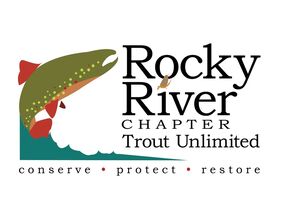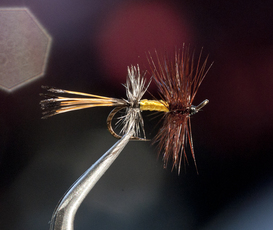Fore and After
Fore and After is an original Southern Appalachian Pattern (SAP) or old timey pattern. However, the fly pattern is definitely a variation of the much older European fore-and-aft fly patterns. We present the pattern using the original Southern Appalachian recipe only.
Fore and After
Fore and After is one of the older Southern Appalachian fly patterns that feature a hackle at the rear and front of the fly. The fore and aft style dry fly patterns date back to the early 1900's with origins that have been disputed between the French and the English. In the book, French Fishing Flies written by Jean-Paul Puguegnot, credit is given to Doctor Juge for creating fore and aft fly patterns in 1918. His Taquine fly pattern consists of a red thread body with grey hackles on the rear and front. Horace Brown of England is also credited for designing fore and aft flies in the 1930's. Either way, the fly pattern was eventually modified by someone in the southern Appalachians using the Golden pheasant tippet tail which is literally a trademark for a number of Southern Appalachian Patterns. Another distinction is the shorter rear hackle rather than both of equal size.
Fore and Aft
The fore and aft style dry fly pattern is a fly with two sections of hackle, one at the shoulder and one at the tip of the body. The design yields a high floater, high riding fly with a tendency to roll around on the surface, placing the hook in various positions. This is a spectacularly useful fishing fly which imitates nothing in particular. Fore and aft flies just do not look all that fishy and no aquatic insects have been found with hackle-like appendages on both ends of their bodies except for a semi-bald caterpillar. My research indicates the original fore and aft fly patterns have hundreds of variations:
Buzz Hackle has a red hackle fibers tail, a grizzly over silver tinsel rear hackle, a peacock herl body and a brown front hackle.
Deren's Stone Fore and Aft has a ginger hackle fiber tail, a gold tinsel ribbing on a yellow body and ginger hackle both rear and front.
Double Badger has no tail, a peacock herl body and badger hackle both rear and front. It is used mainly on rivers but has its uses on still waters also. It is particularly good where there are hatches of Chironimid.
Gray Ugly has a grizzly tail, a peacock herl body and grizzly hackle both rear and front.
Sierra Bright Dot has a Golden pheasant tippet, fluorescent orange floss body and grizzly hackle both rear and front. The pattern has been used primarily on the eastside of the Southern Sierra for many years going back to the 1950's.
Renegade has no tail but rather a gold tinsel tag, a brown rear hackle, a peacock herl body and a white front hackle. The white or light front hackle provides a bivisible effect. As Edward Hewitt would say, "I can see it and the trout can see it." The Red-Butted Double Renegade is a funky variation of the original Renegade. This fly pattern is tied in a fore and aft style with red thread wrapped half way down the bend of the hook (which likely triggers more frequent and aggressive strikes), brown hackle wound near the end of the shank of the hook, peacock herl body, white hackle wrapped in the middle of the shank of the hook, and brown hackle at the eye of the hook.
“The Double Renegade represents nothing specific in nature, but could be suggestive of many things. I have often hypothesized that the fish are taking it for a big ant pattern, but admittedly, I am not sure. I typically fish this fly on small freestone and meadow streams. Brookies, rainbows, and cutthroats go nuts for it, especially when you fish it downstream and then skate the fly back upstream in short jerks. For whatever reason, fish leap up out of the water to hammer it.”- Jim LaFevers
Winnie’s Fore and Aft is a signature invention of Art Winnie in the early 1940’s. This fore-and-aft fly pattern has the addition of upright and divided duck feather wings.
Alen Baker
Fore and Aft
Hook : Tiemco 100 or equivalent, size 12, 14,16,18,20
Thread : Uni 8/0 black or equivalent
Tail : Golden Pheasant Crest fibers
Hackle-abdomen : Grizzly Rooster
Abdomen : Floss, or Dubbing – yellow is standard
Hackle- thorax : Brown Rooster
Directions :
1. Wrap thread starting two eye lengths back from eye in tight, smooth, touching turns to above the hook barb. Let the bobbin hang.
2. Select six or eight Golden Pheasant crest fibers for tail. Make sure before cutting or pulling the fibers that the tips are aligned. Measure the length before tying in by holding the fibers above the hook shank and allow about one and one half the overall length of the shank. Tie in with soft wraps, making sure the fibers stay on top of the hook. When tying in, begin at the hook gap and wrap forward to slightly past the half waypoint. Wrap firmly to the tie in and let the bobbin hang. Trim the excess length of fibers.
3. Select a grizzly rooster feather with barbs shorter than the hook gape. Pull off sufficient fibers to allow for one full wrap before barbs. Tie in at the tie in point of the tail feathers and advance the thread to the half waypoint. Let the bobbin hang. Wrap the grizzly in tight touching turns to about one third the length of the shank. Bring the thread back to the grizzly, tie and trim excess hackle. Let the bobbin hang.
4. The abdomen can be floss or dubbing. We will use floss. Tie in the floss with the black thread, beginning at the grizzly and keeping the floss on top, wrap with black thread to slightly past half way. Let the bobbin hang.
5. Wrap the floss forward using tight and slightly overlapped turns. Spin the floss counter clockwise as you advance to keep the floss flat and not a tight bundle. Tie the floss down with the black thread slightly ahead halfway. Trim excess floss. Let the bobbin hang.
6. Select a brown rooster hackle that is about one and one half the size of the hook gape, prepare as above and tie in where the floss stops. Advance the thread to the hook eye and let the bobbin hang. Wrap the brown rooster as above, stopping two eye lengths back from the eye. Tie in, cut excess and whip finish.

